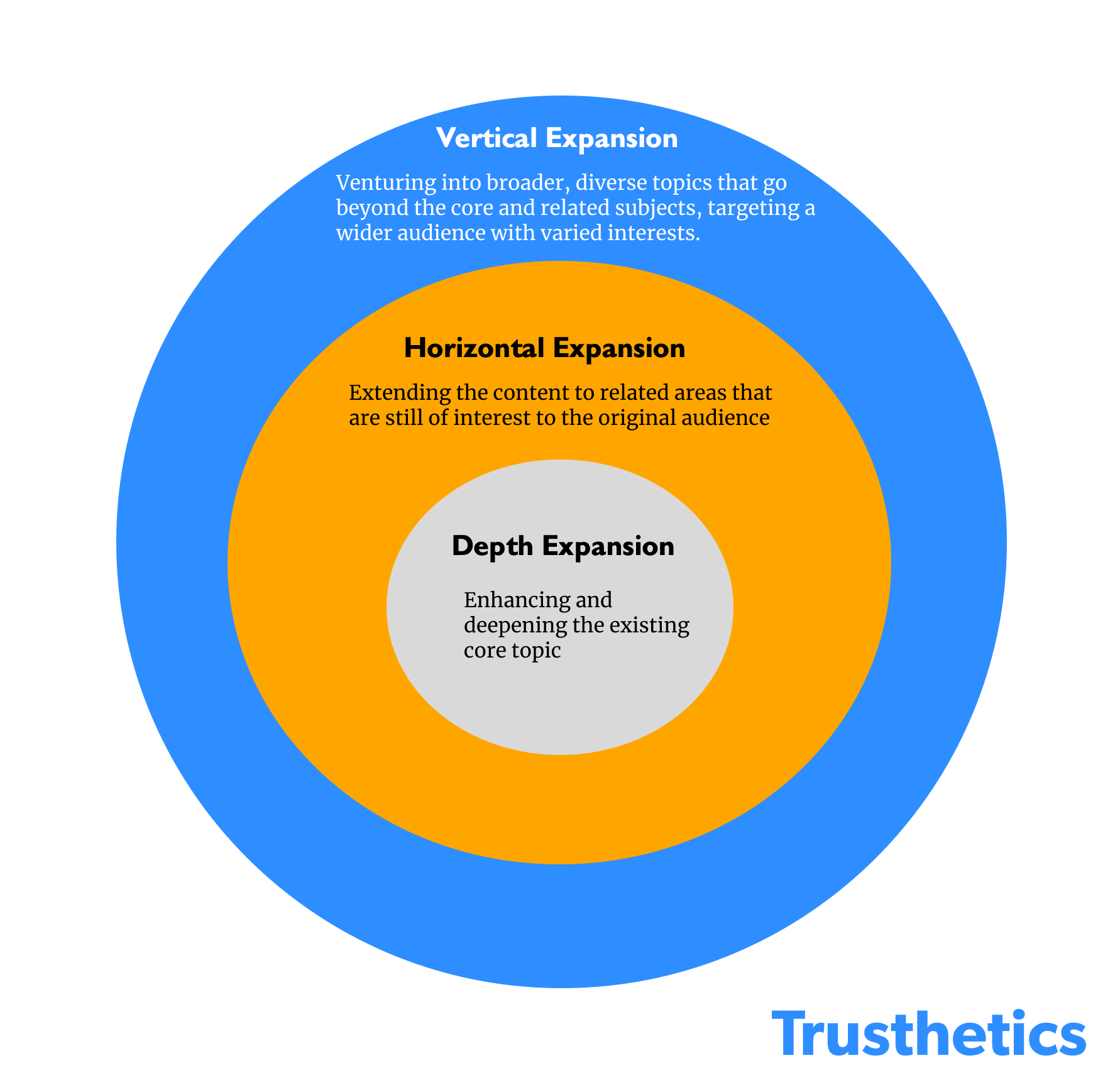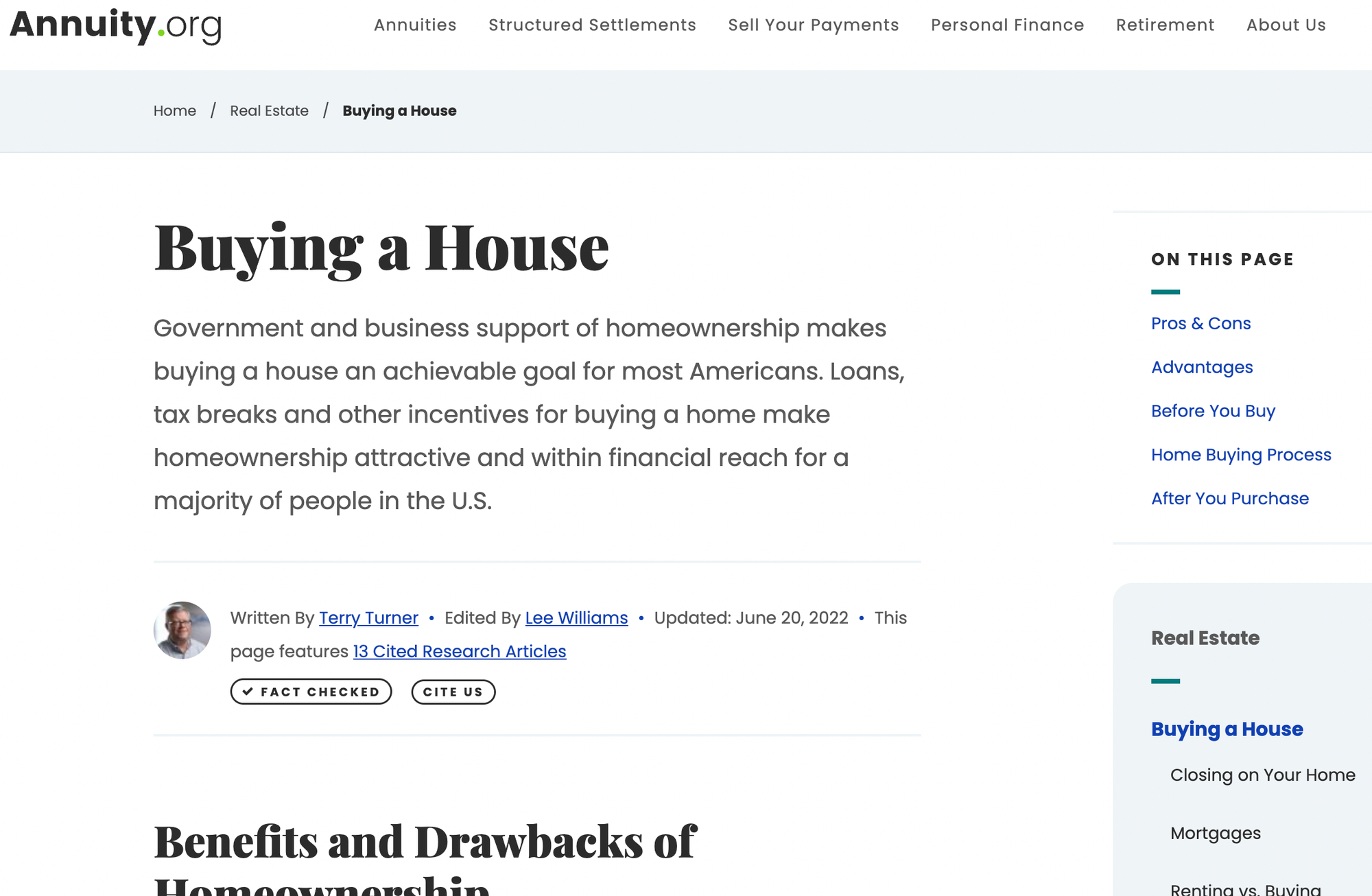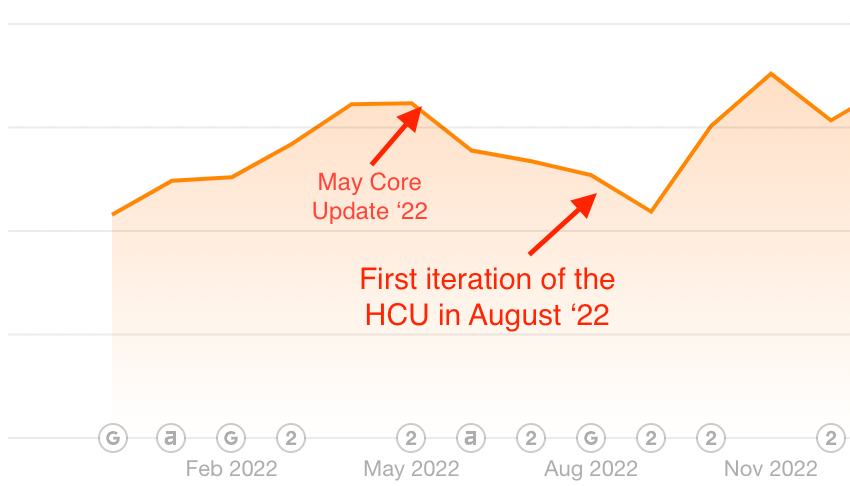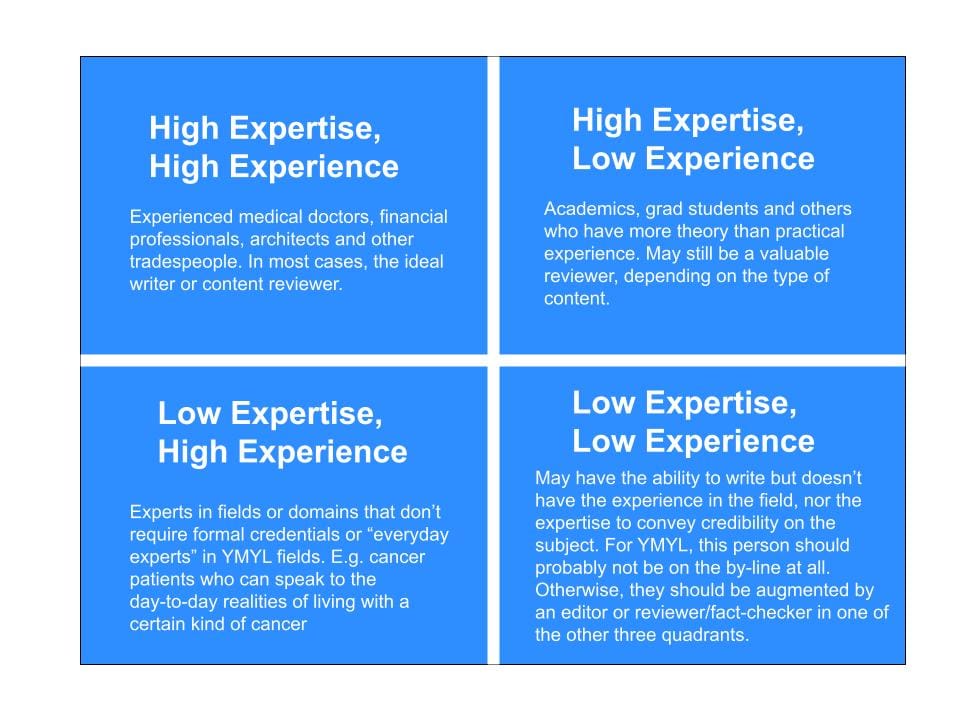How to Think About Expanding Your Brand's Footprint in a Post-HCU World


One thing digital publishers who have traditionally invested in SEO know not to do if they want to survive is to stand still.
The value of fresh content has been beaten into everyone's heads for so long, it's become a meme at this point.
And many sites and brands have aspirations of wanting to expand and publish content beyond what's traditionally been their "sweet spot."
But the old rules about creating content are starting to shift.
Why? Volume.
The web is literally drowning in content.
And much of that content is mediocre at best.
It doesn't add anything to our lives. Unhelpful, to use Google's phraseology.
Even beyond search engines though, the opportunity cost of consuming lousy content takes us away from the stuff that's truly great. The stuff that's savable, shareable and answers our questions. Even questions we wouldn't have even thought of asking.
The problem?
The dial's being turned up to 11 with the rise of both programmatic SEO and AI-generated (and largely un-edited) content spit out of ChatGPT and other LLM-based tools.
This influx of content affects Google most of all. After all, they're the ones that ultimately have to sift through it all and decide if it's valuable enough to index and surface for its users.
That's why their introduction of the Helpful Content Update last August was, in my mind, a turning point in the industry.
It's a site-wide, "always running" ranking signal that specifically targets unhelpful content. There's now been two separate updates to the HCU classifier. And like Core Updates, these changes have had a demonstrable effect on a number of sites and publishers.
Of course what unhelpful content is, exactly, has been left open to interpretation. The phrase "made for search engines" gets thrown around a lot. But as some point out, one could argue literally most content published on the web is made for search engines in some way.
Google itself published documentation with a good list of starter questions for people who are looking for general guidance.
But today I want to talk about a specific scenario. How do you navigate an extension of your content as a publisher in this kind of landscape?
Specifically, how can you expand the focus of your site's content in way that shows alignment with what Google considers a helpful, "people-first" approach to content.
If you're considering a content expansion (or you've been tasked with laying out a plan for one by either your boss or a client), what should you be thinking about?
Not just to put yourself in the best possible position to rank for the topics you want to expand into. But to do so in a way that doesn't risk triggering an unhelpful content designation that could put the rest of your site's traffic at risk.
In this piece, I'll cover:
-Why It's Worth Treading Lightly When It Comes to Content Expansion
-The Different Types of Content Expansion (including a cautionary tale of over-expansion)
-10 Questions to Ask Before Expanding
Let's jump in.
Why Does It Matter
Historically, the traditional SEO playbook for most publishers wanting to expand the depth and breadth of their existing content has generally looked something like this:
- You use your keyword research tool(s) of choice to conduct a deep dive into the topic or topics you're considering expanding into
- You evaluate keyword opportunities based on factors like monthly search volume estimates, competitiveness, revenue potential and other KPIs that might be relevant to the business
- You audit competitor sites and run a content gap analysis for additional ideas and "exploitable gaps" based on the competitor's content.
- You then write a page about said topic that takes into account those gaps, usually focusing on depth above all else because historically, it's proven effective. But on balance, structuring the headers, FAQs and supporting content similarly to what already ranks because hey, that's what's ranking, so this must all be the "right stuff" to include.
(We look at competitors so often that we don't even consider that the blind might be leading the blind, but that's another story for another day.)
This approach worked for a long time. In some cases, it still works.
But I would argue its effectiveness is dissipating. Especially in competitive SEO spaces like YMYL and SaaS.
Google's Helpful Content System, which first went live in August of 2022 was designed to "better ensure people see original, helpful content created for people in search results."
In the announcement, Google released a set of questions for publishers that was intended to bring about some self-reflection and trigger internal dialogue within teams.
The questions were categorized under two headings that paralleled one another: what Google calls "people-first" content and "how to avoid creating content for search engines first."
Based on their public statements about the HCU, Google's aims, to me, are very clearly two-fold:
1.) Algorithmically devalue the kind of low-value, push button AI content that's being spit out of ChatGPT and other 3rd party solutions like Jasper, Chatsonic etc. and published without any degree of crafting or editorial oversight
2.) Algorithmically devalue the boilerplate me-too content put out there by publishers that may not be necessarily wrong or actively harmful, but doesn't add anything new to the collective knowledge about a topic and contributes to the relative "sameness" of the SERPs that some have complained about publicly.
You may have all kinds of perfectly logical reasons for wanting to expand your site's content from what it is today, like:
-Growing into a broader category (and presumably with a bigger audience), so you can generate additional revenue. E.g. a site initially talking about niche financial or health products that wants to talk about broader topics of interest to the audience they may be targeting.
-You've reached what you think is the TAM or what I like to call the TASRE (Total Addressable Search Real Estate) of your market. This often happens in mature verticals where you're already ranking #1 or #2 for most of your queries and there's not enough potential visibility in the long-tail left to attain. Or you're in a market where the search demand for your core topic is declining and you want to hedge your bets by expanding your circle of influence.
-You think there are other audiences that might be interested in your product or service and you want to create content that maps to those potential use cases. As with SaaS or other consumer product companies whom might still be searching for product-market fit.
But if you expand in a way that doesn't take into account where your current "sweet spot" of expertise and credibility lies, you risk putting a lot of effort into content that might not only not rank but serve as an anchor to drag down the rest of your site's traffic.
As Marie Haynes noted in a recent post about Google's AI systems, the game is changing as far as what can realistically be done with "just OK" content:
For quite some time, a skilled SEO could accomplish a lot with on page SEO and link building to improve the ability to rank with medium quality content.
Today, machine learning models help Google decide which content is most aligned with the criteria people consider helpful. This makes it much harder to rank medium level content.
The Different Kinds of Content Expansion
When you're thinking about expanding your content, it first helps to have a framework to assess what you're actually trying to do.
I think of smart content expansion as falling under three main scenarios, as represented by the concentric circles below:

Depth Expansion is building supporting content around the topic that you've already written about the most to add a layer of depth and authority. Your existing sweet spot.
When I worked on Annuity.org, that was the annuity and structured settlement space. We spent the bulk of our time (particularly when I first started working on the site) fleshing out all kinds of content about the different types of annuities, what the buying process for one looked like, what went into how annuity rates were calculated, the different insurance providers that sold annuities etc.
Another example might be if you owned a niche site about gourmet coffee brewing. In that case, your focus might be on things like:
- Different brewing methods (French press, espresso, cold brew etc),
- The different varieties of coffee beans
- Coffee grinding techniques & water quality impact
- Specifics around brewing temperatures
etc.
The next outer circle represents Horizontal Expansion.
In this case, you're writing about complimentary topics while ensuring those topics are still relevant to the Core Topic's audience. Think: related but distinct.
With the Annuity.org example, these were topics like certificates of deposit (CDs), bonds and other annuity-like products that offered conservative investors a relatively safe place to park their money and a guaranteed stream of income.
While they're all distinct products on their own, we knew our core audience of conservative investors nearing retirement were often comparing these products one to one. It made sense to include this content on the site.
In the coffee brewing example, you could expand horizontally by talking about things like:
- Coffee tasting and appreciation
- The science of coffee flavor extraction
- The history and culture of coffee
etc.
Finally, there's vertical expansion.
This is where you're going beyond just trying to expand the breadth and depth of your site's content: you're also trying to appeal to broader audiences beyond just the core topic.
Let's go back to the Annuity.org example.
Generally speaking, most people buy an annuity for a small set of reasons:
- Protecting their nest egg (in a way that's insulated from stock market fluctuation)
- Generating modest income in retirement
- Leaving something for their next-of-kin upon passing
All of these goals could conceivably fall under the more general bucket of retirement planning.
Expanding vertically, in this case, would be to cover broader retirement topics like:
- Social Security Benefits and how to apply for them
- How to come up with a retirement plan
- Other retirement-oriented savings vehicles (401ks, IRAs)
- Estate planning
- Lifestyle topics (e.g. the best states to retire in)
etc. etc.
The key thing to recognize with content as part of a vertical expansion is this: it goes afield but not adrift.
What do I mean?
While not everyone interested in an annuity is going to be equally interested in every topic under the broader umbrella of retirement (and vice versa), it's likely that the core demographic or audience interested in annuity topics and retirement topics is going to be largely the same: people nearing retirement age, wanting to make sure they have enough income to fund their lifestyle without running out of money.
In the theoretical coffee example, vertical expansion might include broader topics that a coffee enthusiast might be interested in but aren't directly related to brewing. For instance, you could talk about:
- The economics of the coffee industry
- The perceived health benefits of drinking coffee (and how accurate they are)
- Sustainable coffee farming and growing
etc.
Beyond this kind of vertical expansion, you're likely putting yourself in a perilous position by creating content that lives outside these parameters.
Here's what I mean:
A Cautionary Tale of Over-Expansion
How far is too far when it comes to content expansion?
Obviously, there's no hard and fast rule.
It's up to you as the publisher to make the determination based on what Google's looking for and how that maps to your brand's goals.
But let's re-visit Annuity.org because it's an instructive example of where I think you can go too far.
Back in 2021, we started laying the groundwork for plans to expand our content even further. Namely: the even broader circle of personal finance.
There were a number of ancillary business reasons for the company ultimately deciding to go in that direction, which I won't get into.
But I ultimately thought, as a team, we could figure out how to plot an intelligent path forward to create content that over time would transform the site into a broader personal finance destination that in due time could consistently compete in the SERP with the likes of Bankrate, Investopedia, Nerdwallet, SmartAsset and some of the other digital goliaths in this space. Particularly since we already were outranking many of them for annuity-related terms.
And so I worked with my colleagues to put together a strategy that I thought, on paper, made sense.
We put together a plan to tackle some of the bigger umbrella topics within personal finance over the next few months. Things like:
- Credit & Debt
- Taxes
- Banking
- Wealth Management

My biggest concern at the time was topical authority and relevance. I wanted to start out by covering areas in personal finance that had at least some overlap with our core topic. So sub-categories under Personal finance like Banking and Investing, for instance, were an initial focus, given that some of our existing content (e.g. certificates of deposit) could be neatly folded under that heading.
By Q2 of 2022, we had published hundreds of pages of Personal Finance content. And many pages were ranking well for all kinds of (mostly) definitional terms. Really well, in some cases. Clearly, some of the content was proving helpful for people and the rankings were reflecting that.
As the months went on though, it was clear that both myself and the team had made a mistake.
By the time the summer of 2022 had rolled around, a Core Update (May of 2022) as well as the first Helpful Content Update had decimated the site's traffic over a period of just a few months. And not just in the sections where we expanded. But everywhere.

Our bread and butter content related to annuities and structured settlements, some of which had been in place since 2014, was down just as much (or even more so) on a percentage basis as the new personal finance content.
We ended up having to go through several rounds of pruning over the next year plus to remove content that we feel didn't meet Google's standards of "helpful."
Looking through the traditional SEO lens, the content wasn't bad by any stretch of the imagination.
As SEOs, we were responsible for providing detailed content briefs to the team for every page we proposed on our roadmap each quarter. And we did.
Each page was accurate, well-written and editorially reviewed. The pages had depth. They was fact-checked by an independent expert.
We even tried to include things like unique case studies and block quotes from experts where we felt they were relevant.
The problems though, as we later saw when going through some of the documentation Google put out as the update was being released, became more obvious.
First of all, the content we were publishing, on balance, didn't add enough new information to the conversation already happening in those spaces.
Most of what we wrote was informational content on topics that had already been well-covered by many other highly authoritative sources for years, sometimes decades. It didn't contribute enough new insights to the collective body of knowledge on the web about each topic. It was classic "me too" content.
It also strayed too far from our core audience. It was in no man's land: outside the concentric circles in the visual above. Which in turn made it look like we were just writing for search engines.
For example, we wrote a ton of long-tail, FAQ-oriented content to flesh out the banking section because based on the traditional SEO playbook I talked about earlier, that that was the intelligent thing to do. Particularly when you're up against some of the monster sites we were up against.
Again, I thought the content itself was helpful for people. But pages about basic banking functions (e.g. "how to write a check") while pertinent for, say, college kids who might've just opened their first bank account, likely wouldn't have any value with our core retirement audience.
And while later on we updated the home page (and other brand pages), we also didn't do a good enough job at the outset of explaining to people why we suddenly were talking about these topics once we started publishing them.
As a result, the Personal Finance content became an anchor weighing down the rest of the site.
Combine that with the multi-year trend of .gov and .gov-adjacent web sites (e.g. non-profit organizations), surfacing for broad, informational terms in a way they hadn't in past years and it became a perfect storm for a loss in overall visibility.
In an effort to be topically authoritative, we missed the more important insight: we were simply trying to be too many things to too many people without the E-E-A-T necessary in the categories we were trying to expand into.
And with a small team with limited resources, this was a recipe for disaster.
Questions to Ask Yourself Before You Think About an Expansion
OK. So what can you do to avoid this fate?
Again, there are no hard and fast rules here.
But I would start by asking yourself these questions:
1.) How far afield is the content you're thinking about writing from my core topic?
Think back to the concentric circles diagram earlier. Would a longtime reader of your web site find the content in the new area relatable or helpful in any way?
Try this as a thought experiment. Let's say you have an e-mail newsletter for your existing site in your core topic of expertise. (If you don't, just play along!)
Let's say one of your existing subscribers then received an e-mail with content exclusively in this new subject area you're planning on writing about.
How would they react? Would they stare at an article like that in disbelief wondering why it would be included? Would it cause them to consider unsubscribing from your list because the article was so far off the beaten path from what they were originally interested in? Might it cause them to forgot how and why they had signed up for your newsletter in the first place?
If you think the answer to any of those questions is 'yes,' you may want to consider not going into that topic. At least not without making it clear to your existing audience how and why you're expanding.
What about a category expert in your original focus area. (Maybe you have content reviewers, for instance) Would they wonder why you were talking about this? Again, if so, you might want to think twice before diving in.
2.) Do you have something truly original to add to the collective body of knowledge of work on the topic? Or are you over-reliant on aggregation and/or templates?
You might've heard the term "information gain" thrown around in some SEO circles.
From Amanda King in a post for Search Engine Land:
An information gain score is essentially a measure of how unique your content is from the rest of the corpus. Here, the corpus would be all the potential documents that Google analyses in ranking for the particular query searched.
In other words: Google is actively seeking out uniqueness.
Users have signaled that they don't want a first page of results that looks and feels exactly the same: same headers, optimized phrases and covering the exact same ground.
If you're going to rank in this new era of search, you have to add something new to the collective discourse online about the topic you want to write about it.
If you feel like that's not possible, then you probably shouldn't write about it.
The overuse of templates and aggregation of things like user-generated content (UGC) also probably won't lend itself well to ranking in the future. From a a recent Search Engine Land article by Barry Schwartz (quoting Google's Danny Sullivan):
"If you search for information about a new movie, you might have previously encountered articles that aggregated reviews from other sites without adding perspectives beyond what’s available elsewhere on the web. This isn’t very helpful if you’re expecting to read something new. With this update, you’ll see more results with unique information, so you’re more likely to read something you haven’t seen before.”
3.) Do your authors have the credibility needed to write about this new topic?
Do I or my writer have first-hand experience with this topic? Do they have the credentials
If not, can I find someone to write or review the content who does?
If answers to both questions are a no, it's an immediate red flag that you probably shouldn't write about it.
If you're unsure, review the credibility quadrant to better help determine how your authors measure up relative to the topic you're looking to expand into.

4.) Do you intend to create content to cover multiple intents and/or all of the different parts of the user's journey in this new area?
In a way, this goes back to topical authority.
Focusing only on transactionally-oriented content in the category you're looking to expand into, for instance, may unwittingly signal to Google that you don't actually have the authority and credibility to be writing about it from a position of authority. And that maybe you're only writing pages to rank and make money. (Even if that's not your intention.)
There's no magic formula for how much informational, transactional, navigational etc. content to create. But you want to make sure you have a plan to create content to cover all aspects of your target user's journey. Not just one.
5.) How has Google reacted before to any content expansions your team has done in the past?
Theories and frameworks can be useful. But in the end, they're just theories.
Same with other people's case studies (including mine!)
What's better is real-life data.
If you have data from previous expansion efforts, go through and measure what happened to your traffic before and after the expansion.
Analyze the data at both a site and category level and pay particular attention to any lifts or drops that happened on or around major algorithm updates that may overlap with the time periods you're looking at.
6.) How big an audience do you already have?
If you're familiar with a lot of the chatter in the SEO world over the last year, you'll know a common point of contention has been the emerging dominance of big brands in categories that instinctually, you'd think they wouldn't belong in. Especially in the product review space where a lot of well-known brands have built "thin Wirecutters" to try and leverage their domain strength for visibility.
Google's made public statements indicating that they're aware of the backlash (at least from publishers), so there's a chance this may change at some point. But it's a hard circle to square, particularly with brands that have cache with their readers and produce otherwise good content.
If you already have a big bucket of existing content and things you're known for, the truth is you have more leeway to go into previously uncharted territory than a niche site that may be known for a more specific thing.
7.) How much (good!) content can you realistically expect to "come out of the gate" with?
This comes down to the capacity that you and your editorial team have to produce content at a high enough bar where there are little to no compromises in terms of quality.
Content can always be edited, massaged and made better over time. And you shouldn't wait forever to publish.
But you also don't want to ship junk. You don't want to compromise and publish content that's missing key features just to hit some manufactured goal. That's liable to bite you.
Determine how much content in the new category you can comfortably publish and at what cadence.
8.) Am I able to write all of this new content while at the same time keeping my existing content fresh and without being buried with "content debt?"
Developers refer to technical debt as:
the cost of technical decisions that are made for immediacy, simplicity, or budget
Content produced at any kind of scale works similarly in that there's a maintenance cost that has to be paid at some point.
The more evergreen content you publish, the more time your team has to carve out in order to keep that content updated, lest it fall out of date and potentially harm the rest of the site as a result.
The opportunity cost here is the new, potentially innovative content that could have been written if the team wasn't otherwise occupied with updating existing evergreen content. Given the same amount of resources, one comes at the expense of the other.
So if what you're writing about is something that changes regularly or contains information that otherwise needs to change regularly (e.g. event times and dates, financial rates, information specific to a given tax year) you need to be able to carve out time to commit to making those updates. (And no, playing games with update dates is not a viable, long-term solution to this problem.)
9.) If I am considering expanding the brand to new audiences, am I able/willing to do the work necessary to explain the reason for the expansion to my existing audience?
If what you're doing is actually more akin to a brand expansion, then that's the way you should think about it.
Rather than surprising your existing visitors (and Google) you might want to ask yourself the following:
- Do I need to change my Mission Statement?
- How much of my About page and other branded content might need to change to accommodate the new section(s)?
- Is there anything in the Privacy Policy that should be reviewed or expanded upon?
- Are there other channels I'm involved with (social, e-mail) that need to be adjusted?
- Can you send out a press release informing people of the new expansion?
10.) Are you committed to testing and evaluating the new content's performance? (and pulling the plug on it if necessary?)
After the content's deployed, it's a good idea to isolate and keep track of not just how the new pages/sections are performing but also what's happening to your "core" content at the same time.
In the time period after deployment, you need to be considering:
- How quickly are the new pages being indexed?
- How quickly are the new pages attaining traffic and rankings for their targeted keywords? Are they accumulating featured snippets?
- Of the new pages/sections that were deployed, which aren't gaining traction? What can you glean from the results as to why they might not be gaining traction?
- How are the "core" content sections performing since the deployment of the new content? Are they maintaining/gaining visibility? Or are you seeing slippage in terms of rankings/traffic/conversions?
This can be tricky if you're not paying attention to things section by section. For instance, heavy gains from the new content (or even seasonality) might be lifting overall site traffic and visibility up overall, even though your bread and butter sections could be declining at the same time.
You also need to prepare for the scenario that despite your best efforts, the new content simply isn't ranking and/or is bringing down the rest of the site and you may have to prune it by either 301'ing it to other, relevant sections on the site or creating customized 404 pages for people who may stumble on content you remove.
Takeaways
To summarize:
- Traditional methods of SEO and "me-too" content creation are becoming less viable thanks to the glut of content being produced, both now and in the future as AI tools get better and better. Creating genuinely original content that adds to the collective knowledge of what's out there on the topic is the best thing you can do to solidify your brand's visibility going forward.
- Expanding the scope of your site's content is fine, but it's crucial to do so thoughtfully before you dive in, rather than creating a bunch of stuff quickly and hoping for the best in the name of "agility". Expansion should align with the site's existing sweet spot and have some connection to that audience. Remember: afield but not adrift.
- Beyond relevance to the core topic, publishers should also think about things like: the uniqueness of the content, E-E-A-T of their authors, coverage of multiple user intents, and their team's ability to maintain and update new content.
- Review the ten questions above before you start laying the groundwork for any type of content expansion.
As always, feel free to reach out if you have questions!
